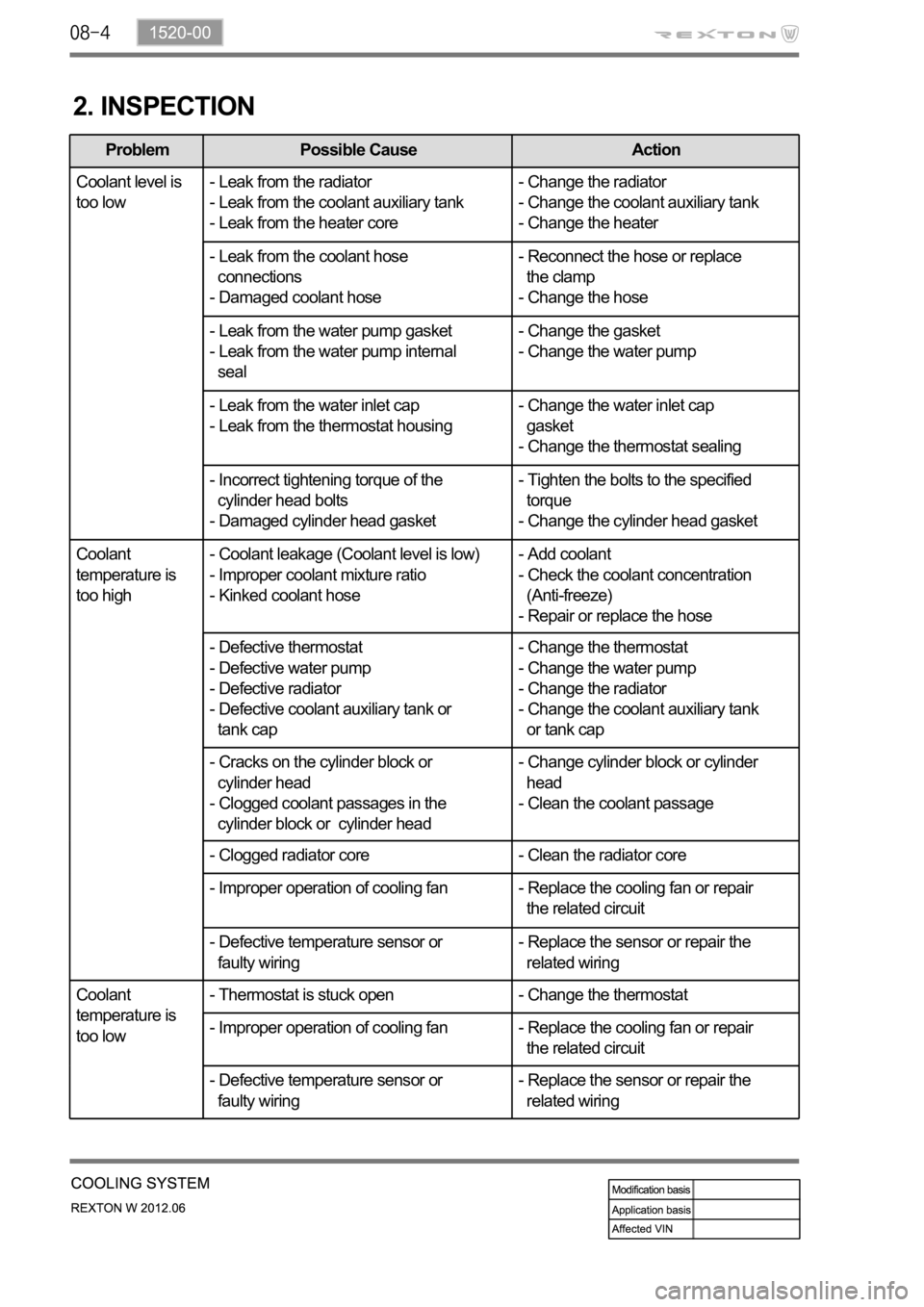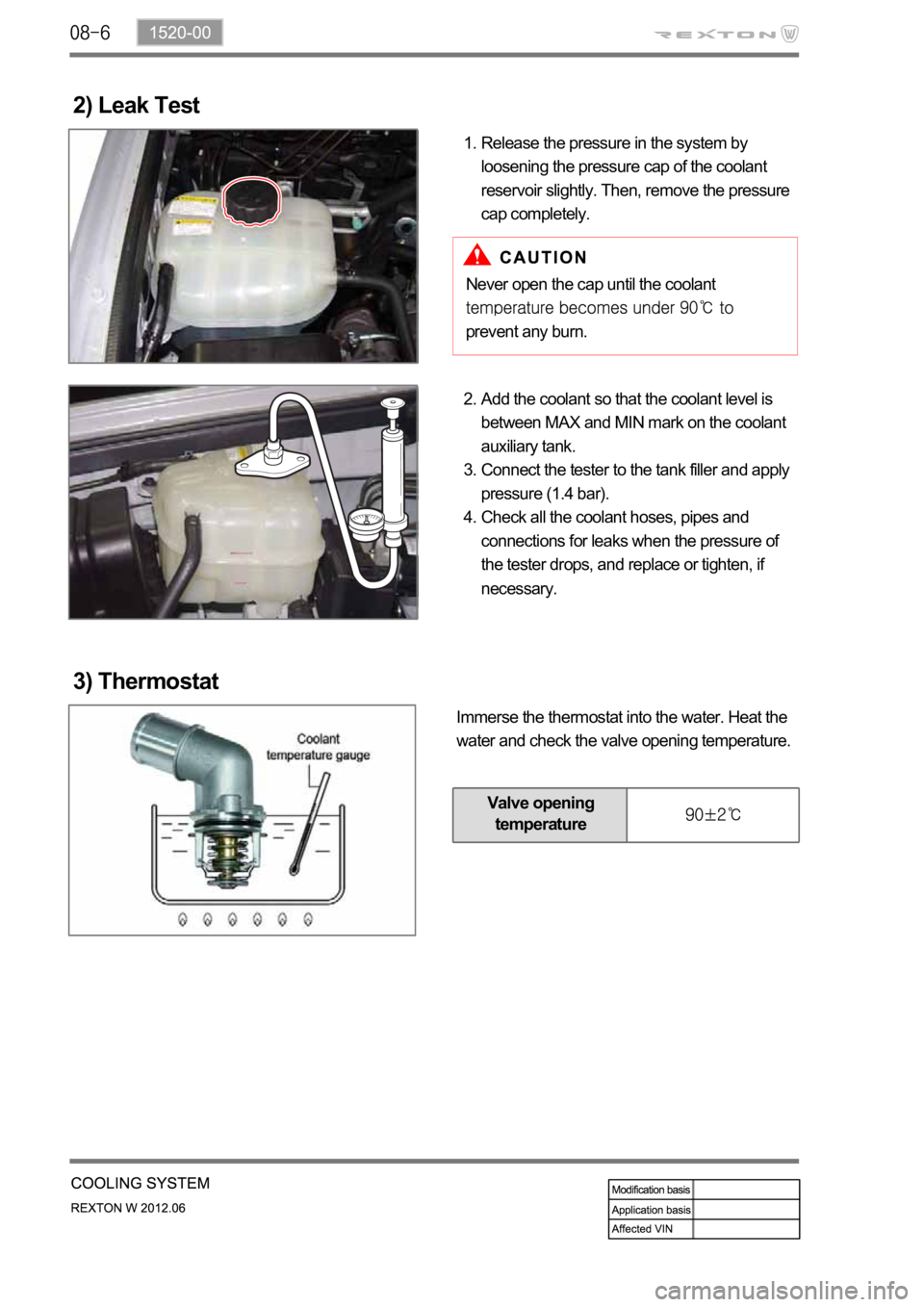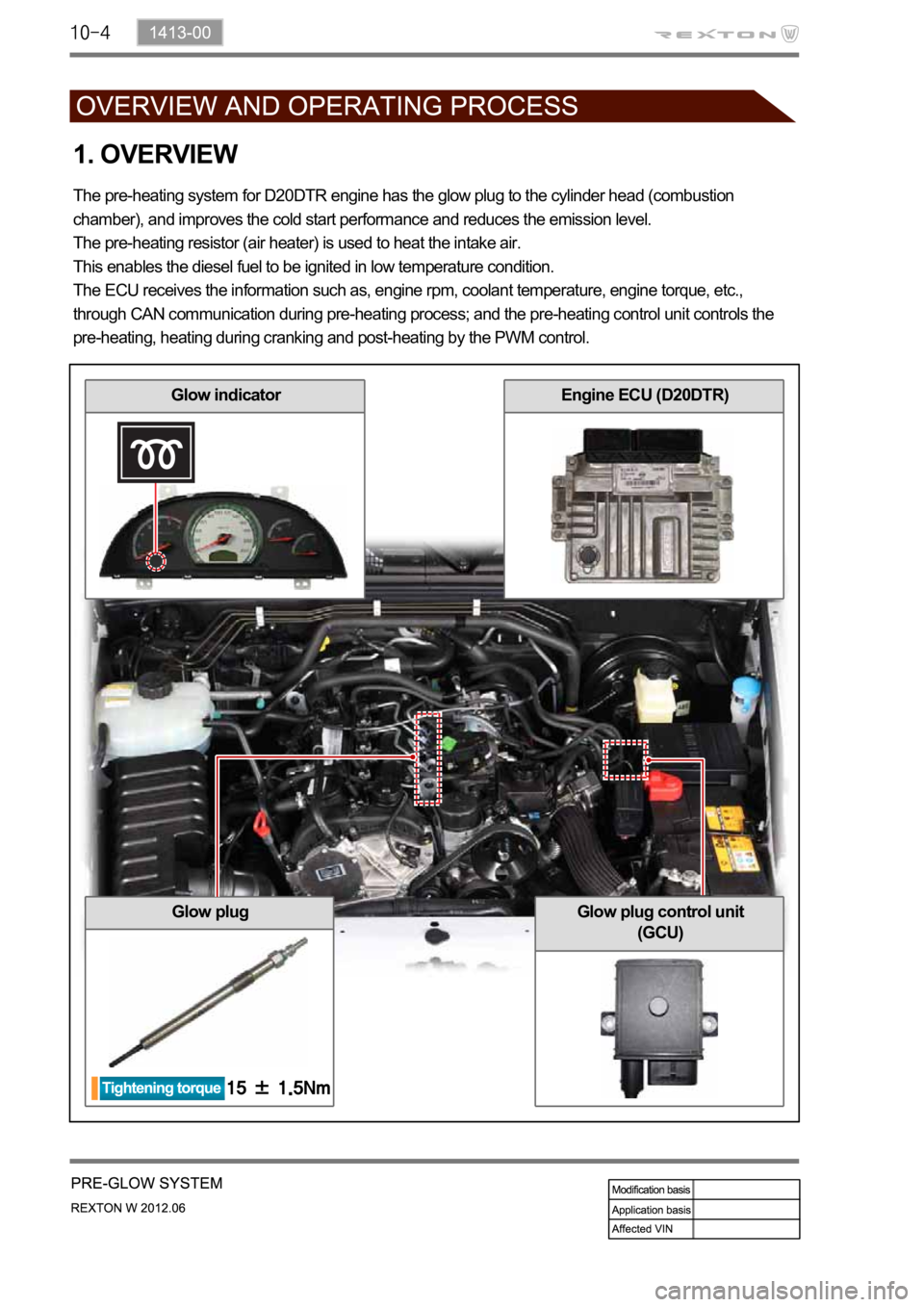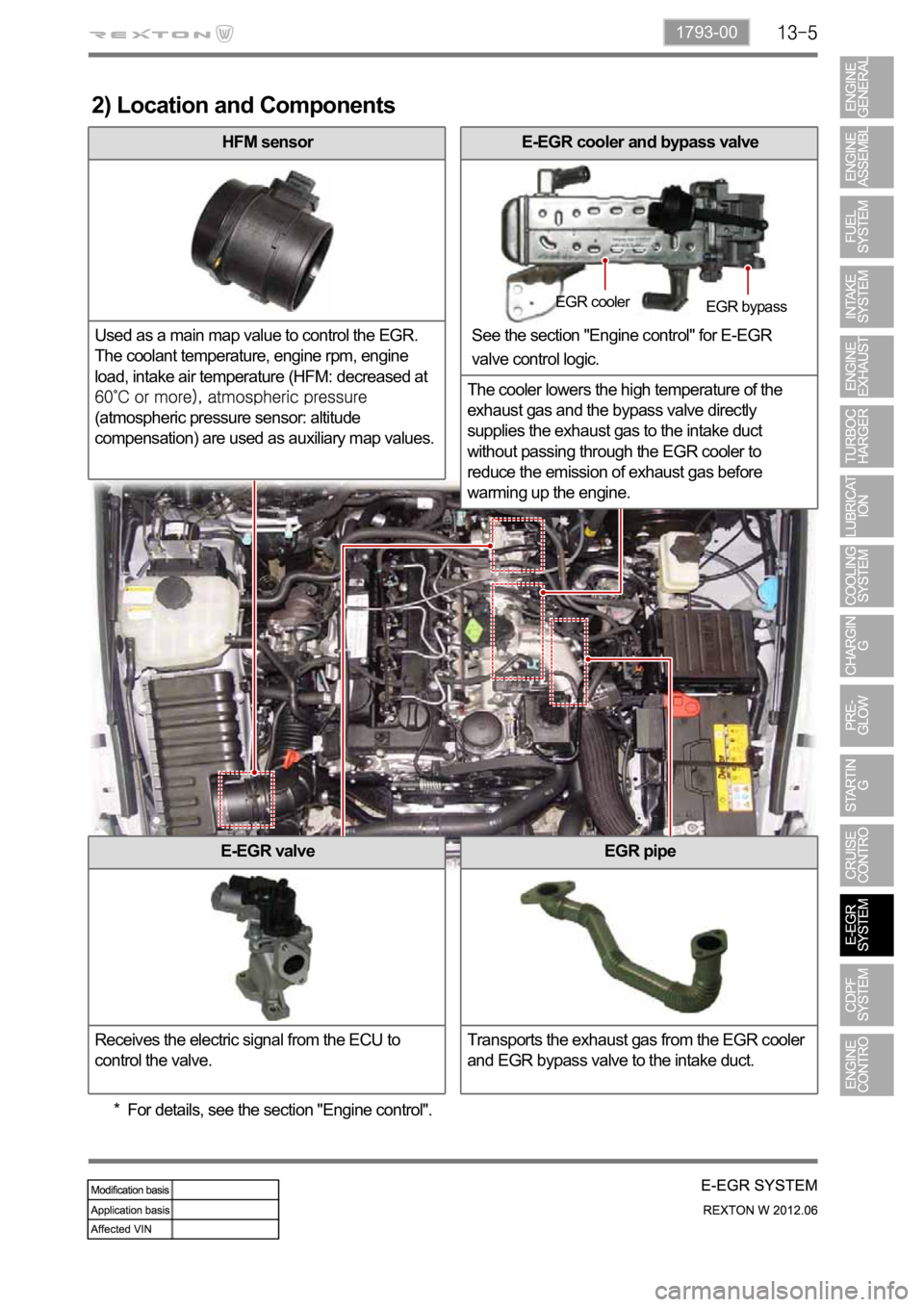coolant temperature SSANGYONG NEW REXTON 2012 User Guide
[x] Cancel search | Manufacturer: SSANGYONG, Model Year: 2012, Model line: NEW REXTON, Model: SSANGYONG NEW REXTON 2012Pages: 600, PDF Size: 73.29 MB
Page 370 of 600

1914-01
E-VGT turbocharger
Improves engine power
2. COMPONENTS
Engine ECU (D20DTR)
E-VGT duty controlAccelerator pedal position
sensor
Transfers driver's will to
accelerate to ECU
Atmospheric pressure, RPM
signal
HFM sensor
Improves the engine powerCoolant temperature sensor
Operates the VGT according to
engine warm-upT-MAP sensor
Booster pressure and
temperature
Page 378 of 600

1520-00
1. SPECIFICATION
Unit Description Specification
Cooling system Type Water cooling, forced circulation
Coolant Capacity approx. 8.5 L
Radiator Core size 662.1W x 510H x 27T
Flow type Cross flow
Min. cooling capacity over 72,000 kcal/h
Antifreeze Type Long life coolant
Mixing ratio
(water:antifreeze)50 : 50
Cooling fan module Type Electric
Capacity
Control type PWM type
Coolant reservoir Capacity over 1.5 L
Circulation Closed roof type
Pressure cap Screw type, 1.4bar
Vacuum valve Screw type, 1.4bar
Thermostat Type Wax pallet type
Opening temperature
Fully open temperature
Valve lift 8 mm
Page 379 of 600

2. INSPECTION
Problem Possible Cause Action
Coolant level is
too low- Leak from the radiator
- Leak from the coolant auxiliary tank
- Leak from the heater core- Change the radiator
- Change the coolant auxiliary tank
- Change the heater
- Leak from the coolant hose
connections
- Damaged coolant hose- Reconnect the hose or replace
the clamp
- Change the hose
- Leak from the water pump gasket
- Leak from the water pump internal
seal- Change the gasket
- Change the water pump
- Leak from the water inlet cap
- Leak from the thermostat housing- Change the water inlet cap
gasket
- Change the thermostat sealing
- Incorrect tightening torque of the
cylinder head bolts
- Damaged cylinder head gasket- Tighten the bolts to the specified
torque
- Change the cylinder head gasket
Coolant
temperature is
too high- Coolant leakage (Coolant level is low)
- Improper coolant mixture ratio
- Kinked coolant hose- Add coolant
- Check the coolant concentration
(Anti-freeze)
- Repair or replace the hose
- Defective thermostat
- Defective water pump
- Defective radiator
- Defective coolant auxiliary tank or
tank cap- Change the thermostat
- Change the water pump
- Change the radiator
- Change the coolant auxiliary tank
or tank cap
- Cracks on the cylinder block or
cylinder head
- Clogged coolant passages in the
cylinder block or cylinder head- Change cylinder block or cylinder
head
- Clean the coolant passage
- Clogged radiator core - Clean the radiator core
- Improper operation of cooling fan - Replace the cooling fan or repair
the related circuit
- Defective temperature sensor or
faulty wiring- Replace the sensor or repair the
related wiring
Coolant
temperature is
too low- Thermostat is stuck open - Change the thermostat
- Improper operation of cooling fan - Replace the cooling fan or repair
the related circuit
- Defective temperature sensor or
faulty wiring- Replace the sensor or repair the
related wiring
Page 381 of 600

2) Leak Test
Release the pressure in the system by
loosening the pressure cap of the coolant
reservoir slightly. Then, remove the pressure
cap completely. 1.
Never open the cap until the coolant
prevent any burn.
Add the coolant so that the coolant level is
between MAX and MIN mark on the coolant
auxiliary tank.
Connect the tester to the tank filler and apply
pressure (1.4 bar).
Check all the coolant hoses, pipes and
connections for leaks when the pressure of
the tester drops, and replace or tighten, if
necessary. 2.
3.
4.
3) Thermostat
Immerse the thermostat into the water. Heat the
water and check the valve opening temperature.
Valve opening
temperature
Page 383 of 600

Water pump
The water pump is driven by the engine drive belt and supplies
the coolant to each area of the engine.
Coolant reservoir
Long life coolant is used.
Thermostat
When the engine coolant
starts to open (fully open at
flow to the radiator to maintain
the engine temperature.
1. SYSTEM DESCRIPTION
1) Overview
Water pump
Impeller vane Sealing
Oil filter module
Page 384 of 600

1520-00
Electric fan
Circulates the fresh air forcibly to exchange heat
with the radiator core fin.
Radiator
Releases heat through fins and cools down the hot
coolant as the coolant passes through the tube of the
radiator core.
Coolant temperature sensor
Measures the coolant
temperature and sends the
result to the engine ECU.
Page 397 of 600

1. OVERVIEW
The pre-heating system for D20DTR engine has the glow plug to the cylinder head (combustion
chamber), and improves the cold start performance and reduces the emission level.
The pre-heating resistor (air heater) is used to heat the intake air.
This enables the diesel fuel to be ignited in low temperature condition.
The ECU receives the information such as, engine rpm, coolant temperature, engine torque, etc.,
through CAN communication during pre-heating process; and the pre-heating control unit controls the
pre-heating, heating during cranking and post-heating by the PWM control.
Glow plug
Glow indicatorEngine ECU (D20DTR)
Glow plug control unit
(GCU)
Page 400 of 600

1413-00
Voltage pattern in actual stepGCU PWM control
4) Operation
Glow plug is installed in the cylinder head. It enhances the cold starting performance and reduces the
exhaust gas during cold starting.
ECU receives the data (engine rpm, coolant temperature, vehicle speed) through CAN lines. Based on the
data, GCU controls the pre-glow, cranking and post-glow. It also checks the glow plugs, and sends the
result to ECU.
Duty control area:
Between 5 and 100%
Frequency: 20 Hz
1.
2.
3.
(1) Temperature/Current Properties of GCU
FETs (similar to transistor) for each cylinder are integrated in GCU. During the pre-glow period, battery
voltage is supplied to the glow plugs directly to heat them rapidly.
After getting the desired temperature by pre-glowing, the temperature is controlled by duty ratio. 1.
2.
3.
Frequency:
20~33Hz
PWM control duty
ratio
- 1st step: 100%
- 2nd step: 35%
- 3rd step: 23%
This describes the voltage supplying types to glow plugs. This shows the supplying voltage and
time by GCU in each step. The 3rd
step is the period to keep the
temperature.
(2) Operation Type of GCU
Page 401 of 600

(3) Operation
Pre-Glow: Step 1
If normal communication with the ECU is established 2 seconds after the power is supplied to the IGN
terminal from the battery, the GCU supplies the battery power to raise the temperature of the glow plug
- The time for pre-heating is controlled by the ECU.
Input power VB(V) Arrival time T1(s)
68.27
75.8
84.1
93.15
10 2.4
11 1.95
1.9
If the input power (VB) is 11.5 V or less, the GCU supplies the battery power for arrival time (T1).
If the input power (VB) is greater than 11.5 V, the GCU supplies the voltage of 11.5 V for arrival time
(T1). -
-
The time for pre-heating by coolant temperature can vary slightly depending on e.g. other vehicle
operation elements.
Page 421 of 600

1793-00
E-EGR valve
Receives the electric signal from the ECU to
control the valve.
E-EGR cooler and bypass valve
The cooler lowers the high temperature of the
exhaust gas and the bypass valve directly
supplies the exhaust gas to the intake duct
without passing through the EGR cooler to
reduce the emission of exhaust gas before
warming up the engine.
2) Location and Components
HFM sensor
Used as a main map value to control the EGR.
The coolant temperature, engine rpm, engine
load, intake air temperature (HFM: decreased at
(atmospheric pressure sensor: altitude
compensation) are used as auxiliary map values.
EGR pipe
Transports the exhaust gas from the EGR cooler
and EGR bypass valve to the intake duct.
See the section "Engine control" for E-EGR
valve control logic.
EGR cooler
EGR bypass
For details, see the section "Engine control". *